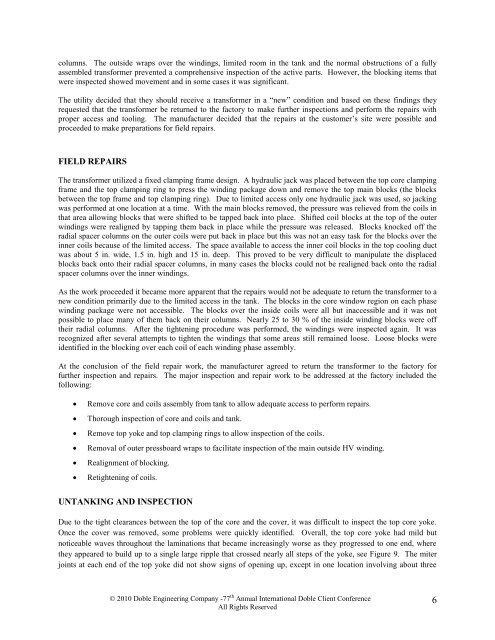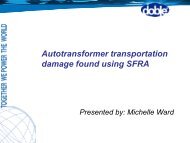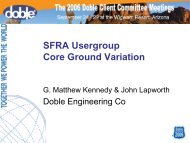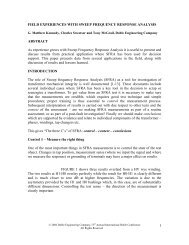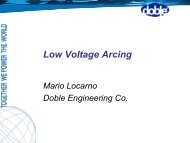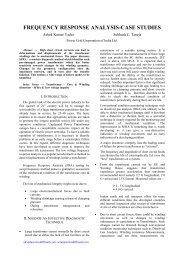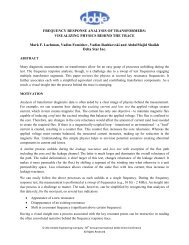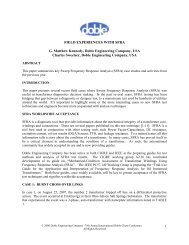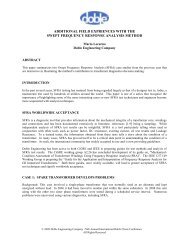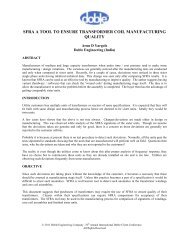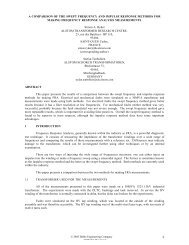Transformer Transportation Damage, A Case Presentation of a Low ...
Transformer Transportation Damage, A Case Presentation of a Low ...
Transformer Transportation Damage, A Case Presentation of a Low ...
Create successful ePaper yourself
Turn your PDF publications into a flip-book with our unique Google optimized e-Paper software.
columns. The outside wraps over the windings, limited room in the tank and the normal obstructions <strong>of</strong> a fully<br />
assembled transformer prevented a comprehensive inspection <strong>of</strong> the active parts. However, the blocking items that<br />
were inspected showed movement and in some cases it was significant.<br />
The utility decided that they should receive a transformer in a “new” condition and based on these findings they<br />
requested that the transformer be returned to the factory to make further inspections and perform the repairs with<br />
proper access and tooling. The manufacturer decided that the repairs at the customer’s site were possible and<br />
proceeded to make preparations for field repairs.<br />
FIELD REPAIRS<br />
The transformer utilized a fixed clamping frame design. A hydraulic jack was placed between the top core clamping<br />
frame and the top clamping ring to press the winding package down and remove the top main blocks (the blocks<br />
between the top frame and top clamping ring). Due to limited access only one hydraulic jack was used, so jacking<br />
was performed at one location at a time. With the main blocks removed, the pressure was relieved from the coils in<br />
that area allowing blocks that were shifted to be tapped back into place. Shifted coil blocks at the top <strong>of</strong> the outer<br />
windings were realigned by tapping them back in place while the pressure was released. Blocks knocked <strong>of</strong>f the<br />
radial spacer columns on the outer coils were put back in place but this was not an easy task for the blocks over the<br />
inner coils because <strong>of</strong> the limited access. The space available to access the inner coil blocks in the top cooling duct<br />
was about 5 in. wide, 1.5 in. high and 15 in. deep. This proved to be very difficult to manipulate the displaced<br />
blocks back onto their radial spacer columns, in many cases the blocks could not be realigned back onto the radial<br />
spacer columns over the inner windings.<br />
As the work proceeded it became more apparent that the repairs would not be adequate to return the transformer to a<br />
new condition primarily due to the limited access in the tank. The blocks in the core window region on each phase<br />
winding package were not accessible. The blocks over the inside coils were all but inaccessible and it was not<br />
possible to place many <strong>of</strong> them back on their columns. Nearly 25 to 30 % <strong>of</strong> the inside winding blocks were <strong>of</strong>f<br />
their radial columns. After the tightening procedure was performed, the windings were inspected again. It was<br />
recognized after several attempts to tighten the windings that some areas still remained loose. Loose blocks were<br />
identified in the blocking over each coil <strong>of</strong> each winding phase assembly.<br />
At the conclusion <strong>of</strong> the field repair work, the manufacturer agreed to return the transformer to the factory for<br />
further inspection and repairs. The major inspection and repair work to be addressed at the factory included the<br />
following:<br />
<br />
<br />
<br />
<br />
<br />
<br />
Remove core and coils assembly from tank to allow adequate access to perform repairs.<br />
Thorough inspection <strong>of</strong> core and coils and tank.<br />
Remove top yoke and top clamping rings to allow inspection <strong>of</strong> the coils.<br />
Removal <strong>of</strong> outer pressboard wraps to facilitate inspection <strong>of</strong> the main outside HV winding.<br />
Realignment <strong>of</strong> blocking.<br />
Retightening <strong>of</strong> coils.<br />
UNTANKING AND INSPECTION<br />
Due to the tight clearances between the top <strong>of</strong> the core and the cover, it was difficult to inspect the top core yoke.<br />
Once the cover was removed, some problems were quickly identified. Overall, the top core yoke had mild but<br />
noticeable waves throughout the laminations that became increasingly worse as they progressed to one end, where<br />
they appeared to build up to a single large ripple that crossed nearly all steps <strong>of</strong> the yoke, see Figure 9. The miter<br />
joints at each end <strong>of</strong> the top yoke did not show signs <strong>of</strong> opening up, except in one location involving about three<br />
© 2010 Doble Engineering Company -77 th Annual International Doble Client Conference<br />
All Rights Reserved<br />
6


